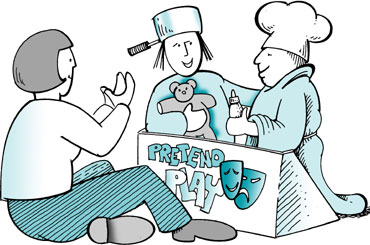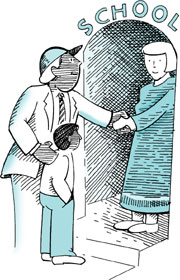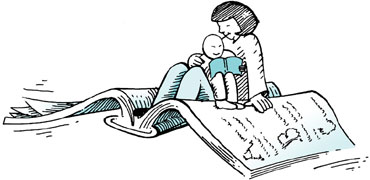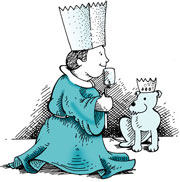The preschool years (ages 2-1/2 to 5) are an exciting time for young children. When they were infants, they developed a trust of their caregivers. As toddlers, they began to establish some independence. Now, as preschoolers, they use this trust and independence to actively explore new forms of play (e.g., pretend play) and new environments (e.g., school).
Preschoolers need to learn how to make choices for themselves and how to feel good about the choices they make. It is their job to "learn to take initiative in socially acceptable ways" (Erikson, 1963).
Preschool-aged children's style of thinking and learning can best be described as "what you see is what you get," or reasoning based on the way things look. Preschoolers rely heavily on the literal appearance of things as a means of understanding the world around them. For example, if a child breaks her graham cracker into four pieces while her brother breaks his in half, she thinks that she has more graham cracker than her brother because she has four pieces and he only has two pieces. Similarly, a child may begin a friendship with another child because of something appealing that the other child has, such as a pretty dress or a new toy.
Adults play an important role in helping children take initiative and explore their environments. Adults' behaviors, attitudes and styles of thinking contribute to preschoolers' development. Talking with children and including them in conversations helps to develop their language skills. It is important to give children opportunities for make-believe play. This helps them to understand themselves and others, and encourages their imaginations.
This guide presents the developmental milestones of the preschool years — accompanied by suggestions for how you can foster children's positive development. There is special emphasis on issues relevant to preschoolers, including pretend play, the transition to school, and early literacy.
Development between 30 and 60 months
Each child grows and develops at his or her own rate — displaying developmental landmarks at different times. The table below shows characteristics that children between the ages of 2-1/2 and 5 will typically display as they grow and develop. For each type of development (such as physical, communication, etc.), younger children's characteristics are at the top of each list, older children's are at the bottom.
Table 1
Developmental landmarks between 30 and 60 months
Physical
Characteristics
- Gaining strength and coordination
- Increasing control of hands and use of fingers
- Laces shoes
- Buttons and zips clothes
- Kicks/bounces/catches a ball
- Hammers nails
- Dresses self and ties shoes
- Uses toilet independently
- Paints and draws
- Cuts with scissors
- Threads beads
- Jumps/hops/skips
What can adults do?
- Provide children with appropriate materials for encouraging small muscle development such as crayons, paint brushes, scissors, puzzles, blocks, beads and play dough.
- Provide children with appropriate materials for large muscle development such as balls, tricycles and balance beams.
- Limit television time — help children learn to enjoy being active.
- Create an environment inside and outside the home that encourages physical activity.
- Plan family trips to local parks.
Thinking and learning
Characteristics
- Curiosity
- Cause and effect experimentation
- Recognizes letters and numbers
- Develops an awareness of alike/different
- Develops an awareness of time
- Recognizes colors, shapes and textures
- Develops preference for right or left hand
- Memory skills increase
- Hands-on learning
What can adults do?
- Ask children open-ended questions ("How did you put that puzzle together?").
- Provide opportunities for children to experiment (e.g., mix blue, red, and yellow water; play "sink or float" with cork, rocks, feathers and other objects).
- Display a traditional clock in children's bedrooms; chart chil- dren's daily time schedule and post it on the refrigerator.
- Using old scraps of fabric, create a quilt with different tex- tures, colors and shapes.
- Make a memory game with cardboard and animal stickers or old pieces of wrapping paper.
- Encourage children to talk about the past ("Tell me about your day, today. What did you do? Who did you play with?").
Expressing feelings
Characteristics
- Affectionate
- Developing a sense of humor
- Easily encouraged/discouraged
- Demonstrates intense feelings of fear, joy, anger, love
- May show off and demand attention
What can adults do?
- Help children identify and label their emotions verbally (e.g., "You look like you are feeling sad today; did something happen at school?").
- Encourage children to talk about their feelings, recognizing that it is an opportunity to promote closeness with children.
- Carefully observe, listen and respond to children's emotions.
- Provide baby dolls, puppets, and stuffed animals that children can use in emotional pretend play (e.g., comforting a crying baby doll; pretend argument between stuffed animals).
Awareness of self and others
Characteristics
- Displays independence Engages in pretend play
- Displays self-control
- Shares and takes turns
- Develops friendships
- Shows respect for others' things
- Learning first and last name, address, phone number, age, sex
What can adults do?
- Provide opportunities for children to work independently and in small groups (e.g., encourage siblings to do a puzzle together; establish individual quiet time with books).
- Create environments that support pretend play.
- Assign children simple chores such as watering plants, check-ing the mail, dusting bookshelves and cleaning up their toys.
Communication
Characteristics
- Asks why/what/who/how come
- Possesses a rapidly expanding vocabulary
- Engages in more complicated conversations
- Enjoys making up/telling stories
- Matches letters with those in own name
- Seeks to write name
- Displays musical knowledge
- Improves listening skills
- Uses sentences with correct grammar
- Able to verbally resolve conflicts with other children
What can adults do?
- Encourage children to ask questions.
- Engage in conversations with children such as during dinner time and at bedtime.
- Provide children opportunities to practice copying their name.
- Provide children access to musical instruments such as home- made shakers, drums and bells.
 Pretend play
Pretend play
Preschool children love to play, especially when their play activities involve make-believe. This special type of play, known as pretend play, is particularly important for young children's development. As children's thinking skills improve during the preschool years, they can remember and tell stories that follow a sequence of events and make sense to others. Pretend play is a great way for children to learn and develop skills such as:
- Planning, including organizing the type of pretend play (such as "the beach"), roles (lifeguard, scuba diver, fisherman), and items/objects needed for the activity (whistle, goggles, flippers, fishing pole, beach towels)
- How to solve problems and compromise (for example, "This time I'll be the lifeguard who rescues you and next time you can rescue me.")
- How to communicate through words and actions
- How to express emotions (for example, fear in the face of a child pretending to be a scary animal; delight or jealousy when a new baby comes home from the hospital)
- Creativity and imagination; pretend experiences get more complicated and fantastic as children get older (for example, instead of simply being fishermen, they become deep sea explorers, searching for lost treasures on a sunken ship)
- Memory skills, as favorite experiences are acted out over and over again (such as getting a new pet, eating at a restaurant, taking a trip to the zoo)
You can promote children's development by creating an environment that supports pretend play. For example:
- Establish an area for children's pretend play and provide a variety of items, including purses, hats, shoes, clothing, telephones, kitchen materials, office supplies, junk mail, etc. Be sure to offer a storage area for pretend play items. For example, children can hang their "dress up" clothes on an old coat rack and store their other pretend play items in a laundry basket.
- Encourage children to talk about their pretend play. Ask them to describe their pretend play to you: Who were they pretending to be? Why did they want to pretend they were that person? What did they get to do? However, don't interrupt children with questions about their play when they are deep into a pretend play experience. Their fantasy experience can easily be disrupted if they have to shift gears and talk to someone outside of their make-believe experience.
- Engage in pretend play with children. You can enhance children's pretend play by offering suggestions for activities and introducing new words into children's vocabulary. Be sure to follow the child's lead. Let the child direct the fantasy play experience. Research shows that children are more agreeable and can express their developing independence when adults follow the child's plan for the play. Examples of adult-child pretend play activities include having tea parties, bathing baby dolls, setting up a restaurant or beauty parlor, and being a librarian or mail carrier.
- Attend to the theme of children's pretend play. Research shows that, compared to children who engage in little or no violent fantasy play, children who engage in noticeably more violent fantasy play tend to be angrier and less cooperative. Examples of violent pretend play activities include aggressive monsters who hurt people or cops and robbers who kill each other.
Transition to school
 As the preschool years come to a close, families are faced with the challenge of preparing their children to start school. Preparing for this transition can make the child's experience (and the family's experience) more comfortable. Transitions from preschool to school involve a shift in caregiver-child relationships and peer relationships — some relationships end while new ones begin. Children often have mixed emotions about this shift, including a sense of sadness about leaving their preschool or child care program, and a sense of excitement and anticipation about beginning school. The ability to deal with these emotions and adapt to these changes is important for a successful transition, which sets a positive tone for children's adventures in school.
As the preschool years come to a close, families are faced with the challenge of preparing their children to start school. Preparing for this transition can make the child's experience (and the family's experience) more comfortable. Transitions from preschool to school involve a shift in caregiver-child relationships and peer relationships — some relationships end while new ones begin. Children often have mixed emotions about this shift, including a sense of sadness about leaving their preschool or child care program, and a sense of excitement and anticipation about beginning school. The ability to deal with these emotions and adapt to these changes is important for a successful transition, which sets a positive tone for children's adventures in school.
Here are some suggestions that can help you prepare your children for these transitions.
- Arrange a visit to the child's new school. Make sure the child meets his or her new teacher and has the opportunity to explore the new classroom.
- Ask your child's new teacher about the routines that your child can expect in the new classroom. For example, find out about naps (Do children take naps? Are naps gradually phased out over the course of the school year?), snacks (How many snack times are there during the day?), and lunch (Do children eat in the cafeteria? Will they have to carry a tray?).
- Incorporate aspects of your child's new routine into his or her current routine. For instance, if children eat lunch in the cafeteria, play a game at home where your child can learn how to balance a tray. If children do not take naps at your child's new school, gradually phase out nap time during your child's daily routine at home. If your child attends preschool or a child care program, ask your child's teacher to help phase out naps.
- Talk with children about what will change and what will stay the same. For example, children may have friends that will be in their new class at school, but they will also get to make new friends. Research suggests that children may adjust better to a change of school when they have the support of a friend. Find out if any of your child's friends will be in the same class. If not, ask your child's teacher to put you in contact with another family whose child will be attending the same school and lives nearby.
- Encourage children to talk about their feelings about starting school.
- When possible, volunteer at your child's school. You can attend field trips, read stories to your child's class, and help with special events. If your job prohibits you from volunteering during the day, you may want to use some personal time to volunteer for a special event at your child's school. Parents who cannot volunteer during the day can help by saving materials for art activities or contributing to the school newsletter.
 Promoting young children's early literacy
Promoting young children's early literacy
To promote young children's delight in talking, listening, reading and writing, adults need to provide a variety of interesting language experiences.
Children who have reading difficulties in the primary grades often had limited early literacy learning experiences. Children with reading difficulties have less letter knowledge, less sensitivity to the notion that sounds of speech are distinct from their meaning, less familiarity with the basic purpose and mechanisms of reading, and poorer general language ability.
Children who are skilled readers understand the alphabet and letters, use background knowledge and strategies to obtain meaning from print, and can easily identify words and read fluently.
Activities that prepare young children for learning to read emphasize:
- Counting
- Number concepts
- Letter names, shapes, and sounds
- Phonological and phonemic awareness
- Models of adult interest in literacy
- Independent and cooperative literacy activities
Key concepts in children's early literacy
Phonological awareness
An appreciation of the sounds and meanings of spoken words. For example, a phonologically aware child can hear and say rhyming words, divide words into sounds and/or syllables and put them back together again, and recognize that groups of words have the same sound at the start (fish, frog, fruit), or the same sound at the end (dice, mice, ice).
Phonemic awareness
An advanced form of phonological awareness. The awareness that printed symbols, such as letters, systematically represent the component sounds of the language. Children who demonstrate phonemic awareness recognize the sound — symbol relationship. Phonemic awareness allows children to "sound out" words.
What adults can do
Be a model of literate behavior for your children: write notes, keep a calendar and daily planner, post lists of food and household needs and children's responsibilities, introduce new vocabulary words during routine conversation and bookreading, and subscribe to a local newspaper and magazines the entire family will enjoy.
Sing songs, make up silly rhymes, read books, and play with words and sounds every day. Discuss printed text, words, and sounds as "objects" that can be thought about, manipulated, altered and explored. Help children build and use their ever-growing vocabulary.
Provide children with the tools of literate behavior (pens, pencils, markers, paper, envelopes, a stapler, paperclips, stamps, a dictionary, an atlas, telephone books, magazines, catalogues, newspapers, junk mail) and engage in daily literacy activities with your children (write thank-you notes, mail birthday cards, look up phone numbers, find exotic destinations in an atlas, write lists, read books, visit the library).
Suggested books for preschoolers
Reading books is one of the most valuable ways that parents can spend time with their children. Reading to children helps them develop an awareness of the sounds of language, understand that letters represent sounds, and value literacy. The books listed below (title, author/illustrator, publisher, publication date) promote children's emerging literacy skills through rhyming, repeated patterns and predictability. Most importantly, they are fun to read!
- Brown Bear, Brown Bear, What Do You See?
By Bill Martin Jr.
Illustrated by Eric Carle
Holt. (1992). - Caps for Sale: A Tale of a Peddler, Some Monkeys, and Their Monkey Business
By Esphyr Slobodkina
HarperCollins. (1987). - Chicka Chicka Boom Boom
By Bill Martin, Jr., and John Archambault
Illustrated by Lois Ehlert
Aladdin. (2000). - If You Give a Mouse a Cookie
By Laura J. Numeroff
Illustrated by Felicia Bond
HarperCollins. (1985). - The Napping House
By Audrey Wood
Illustrated by Don Wood
Harcourt. (1984). - The Polar Express
By Chris Van Allsburg
Houghton Mifflin. (1985). - The Snowy Day
By Ezra Jack Keats
Viking. (1981). - There's a Nightmare in My Closet
By Mercer Mayer
Dutton. (1992). - Where the Wild Things Are
By Maurice Sendak
HarperCollins. (1988). - Dr. Suess books
- Hop on Pop
- The Foot Book
- One Fish, Two Fish, Red Fish, Blue Fish
- Green Eggs and Ham
Conclusion
The preschool years are an active time for young children — their independence and initiative enable them to explore their world in new ways. Parents and teachers have the important task of giving children numerous and varied opportunities to promote their development during the preschool years, including physical development, thinking and learning, expressing feelings, awareness of self and others, and communication. Using the suggestions that have been offered will help to foster a positive, creative environment in which children can thrive.
References
- Burns, M. S., Griffin, P., and Snow, C. E. 1999. Starting Out Right: A Guide to Promoting Children's Reading Success. Committee on the Prevention of Reading Difficulties in Young Children, National Academies Press: Washington, DC.
- Committee on the Prevention of Reading Difficulties in Young Children. 1998. Preventing Reading Difficulties in Young Children. National Academies Press: Washington, DC.
- Dunn, J., and Hughes, C. (2001). "I got some swords and you're dead!": Violent fantasy, antisocial behavior, friendship, and moral sensibility in young children. Child Development, 72, 491-505.
- Erikson, E. (1963). Childhood and society (second edition). New York: Norton.
- Garvey, C. (1990). Play. Cambridge, MA: Harvard University Press.
- Ladd, G.W., Kochenderfer, B.J., and Coleman, C.C. (1996). Friendship quality as a predictor of young children's early school adjustment. Child Development, 67, 1103-1118.
- Rocissano, L., Slade, A., and Lynch, V. (1987). Dyadic synchrony and toddler compliance. Developmental Psychology, 23, 698-704.
- U.S. Department of Health and Human Services. Administration for Children and Families, Head Start Bureau. Effective Transition Practices: Facilitating Continuity. Washington, D.C.
 Amy Halliburton
Amy Halliburton